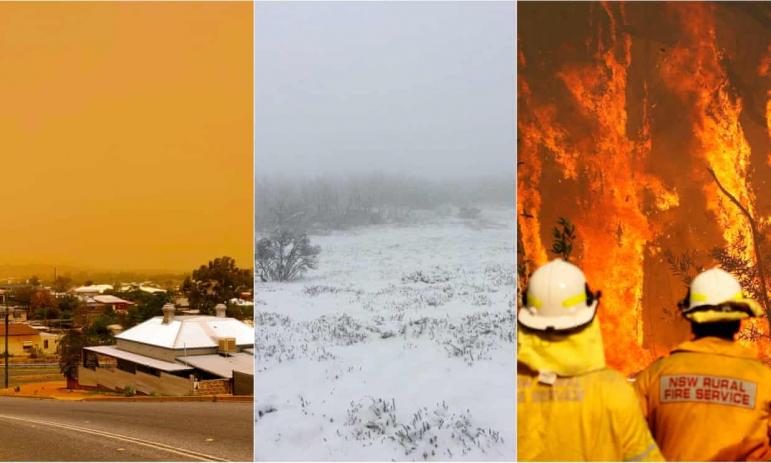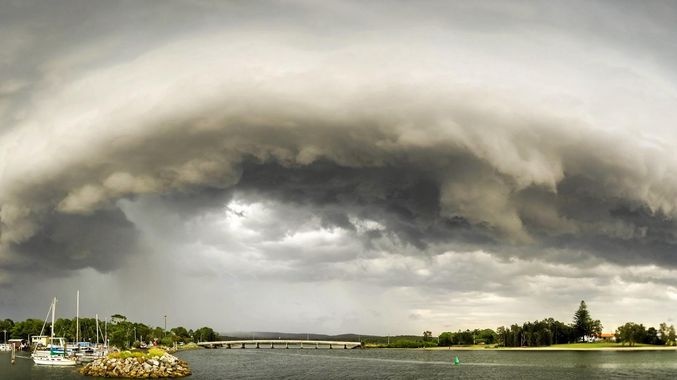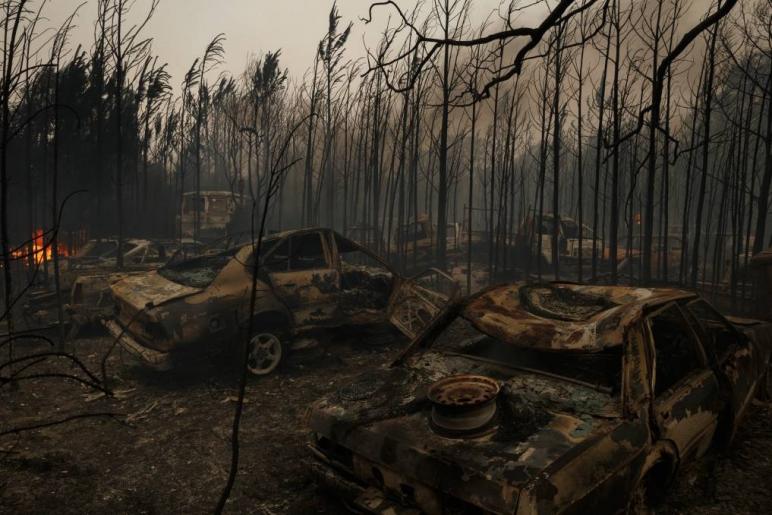Seguimento Oceânia 2018
- Thread starter luismeteo3
- Data de início
-
Meteogramas MeteoPT: Capitais de Distrito/Açores/Madeira | Coordenadas
Seguimento Meteorológico: Litoral Norte | Interior Norte e Centro | Litoral Centro | Sul | Açores e Madeira | Livre Previsões: Curto e médio prazo: até 2 semanas | Longo prazo: mensal e sazonal (Regras e links úteis nos 1ºs posts)
Facebook | Avisos IPMA/Alertas ANEPC
You are using an out of date browser. It may not display this or other websites correctly.
You should upgrade or use an alternative browser.
You should upgrade or use an alternative browser.
Austrália. Sydney atravessa verão mais quente desde 1939
Temperaturas chegaram aos 47,3 graus na região ocidental da cidade australiana
A zona de Penrith, na cidade australiana de Sydney, atingiu este domingo os 47,3 graus Celsius, a mais alta temperatura ali registada nas últimas oito décadas. O recorde anterior era de 1939, quando se testemunharam 47graus.
As autoridades australianas emitiram diversos alertas para risco de incêndio e foram obrigadas a transportar para o hospital dezenas de pessoas - principalmente sem-abrigo -, afestadas por insolação e desidratação.
O calor deixou quase 7 mil casas da região de Nova Gales do Sul sem eletricidade.
Depois de um dos invernos mais secos dos últimos anos, a Austrália enfrenta um dos verões mais quentes de sempre, depois de em 2017 já terem sido quebrados mais de 200 recordes metereológicos.
Para segunda-feira são esperadas temperaturas igualmente altas, mas existe a possibilidade de ocorrência de chuva no final do dia.
https://sol.sapo.pt/artigo/595301/australia-sydney-atravessa-verao-mais-quente-desde-1939
Temperaturas chegaram aos 47,3 graus na região ocidental da cidade australiana
A zona de Penrith, na cidade australiana de Sydney, atingiu este domingo os 47,3 graus Celsius, a mais alta temperatura ali registada nas últimas oito décadas. O recorde anterior era de 1939, quando se testemunharam 47graus.
As autoridades australianas emitiram diversos alertas para risco de incêndio e foram obrigadas a transportar para o hospital dezenas de pessoas - principalmente sem-abrigo -, afestadas por insolação e desidratação.
O calor deixou quase 7 mil casas da região de Nova Gales do Sul sem eletricidade.
Depois de um dos invernos mais secos dos últimos anos, a Austrália enfrenta um dos verões mais quentes de sempre, depois de em 2017 já terem sido quebrados mais de 200 recordes metereológicos.
Para segunda-feira são esperadas temperaturas igualmente altas, mas existe a possibilidade de ocorrência de chuva no final do dia.
https://sol.sapo.pt/artigo/595301/australia-sydney-atravessa-verao-mais-quente-desde-1939
Falta 5 horas para o reinício da estação. Chagará aos 400 mms?

 http://www.bom.gov.au/products/IDW60801/IDW60801.94203.shtml
http://www.bom.gov.au/products/IDW60801/IDW60801.94203.shtml

 http://www.bom.gov.au/products/IDW60801/IDW60801.94203.shtml
http://www.bom.gov.au/products/IDW60801/IDW60801.94203.shtmlalgarvio1980
Furacão
Falta 5 horas para o reinício da estação. Chagará aos 400 mms?

http://www.bom.gov.au/products/IDW60801/IDW60801.94203.shtml
Está quase, falta 3 horas e apenas 4.8 mm, para os 400 mm.
 Espectáculo! Cair 400 mm em Portugal em 24 horas desaparecia do mapa.
Espectáculo! Cair 400 mm em Portugal em 24 horas desaparecia do mapa. 
Batido, já vai em 403.4 mm http://www.bom.gov.au/products/IDW60801/IDW60801.94203.shtml S
Última edição:
Broome chegou aos 412 mms em 24 horas.
Distribuição da precipitação de ontem:

Distribuição da precipitação de ontem:

Just another day in New South Wales: snow, fire, severe thunderstorms, heavy winds and dust storms
The last 24 hours have seen a bit of everything... from dust storms and heavy snow in the southeast, to thunderstorms in the north, and wildfires in the Hunter.


Storm in Evans Head on 21 November 2018. Pics Chris Hosie on North Coast Storm Chasers.

Cars incinerated by the Campvale fire.
A strong low pressure system and associated pool of cold air moved over southeastern Australia on Wednesday and Thursday. This system caused strong winds to flow over dry soil in western NSW, causing a large area of raised that swept across NSW, southern Queensland and northern Victoria. The dust storm was thickest in far western NSW on Wednesday afternoon and had thinned out noticeably when it reached the state's coastline on Thursday. However, there was still enough airborne dust to turn the sky brown in Sydney.
While large areas of NSW and northern Victoria were being covered by dust on Thursday, it was a different story in the alps. A pool of cold air that originated from the Southern Ocean caused temperatures to drop low enough for snow in some areas on Thursday morning. There was enough snow to cover the ground at many of Australia's ski resorts, making it look more like early winter than the end of spring. More snow is expected to fall over the next couple of days as the cold air lingers over the mountains.
Further north, a low pressure trough sweeping over southeast Queensland on Thursday triggered intense thunderstorms. Severe storms warnings were issued in Brisbane and surrounding areas late in the morning as the line of storms passed through the region. Archerfield registered a wind gust of 83km/h during the storms and 16mm of rain fell in just half an hour at Amberley Airport.
The Bureau of Meteorology on Friday issued a severe weather warning for damaging winds over the state’s southeast – stretching from the Victorian border up to the Hunter region, where a mass of dry air combined with gusty winds to produce Severe to Catastrophic fire danger ratings on Thurday and Friday, prompting total fire bans- which are rare this early in the season.
https://www.eldersweather.com.au/news/snow-fire-thunderstorms-and-dust-storms-all-in-one-day/528804
The last 24 hours have seen a bit of everything... from dust storms and heavy snow in the southeast, to thunderstorms in the north, and wildfires in the Hunter.


Storm in Evans Head on 21 November 2018. Pics Chris Hosie on North Coast Storm Chasers.

Cars incinerated by the Campvale fire.
A strong low pressure system and associated pool of cold air moved over southeastern Australia on Wednesday and Thursday. This system caused strong winds to flow over dry soil in western NSW, causing a large area of raised that swept across NSW, southern Queensland and northern Victoria. The dust storm was thickest in far western NSW on Wednesday afternoon and had thinned out noticeably when it reached the state's coastline on Thursday. However, there was still enough airborne dust to turn the sky brown in Sydney.
While large areas of NSW and northern Victoria were being covered by dust on Thursday, it was a different story in the alps. A pool of cold air that originated from the Southern Ocean caused temperatures to drop low enough for snow in some areas on Thursday morning. There was enough snow to cover the ground at many of Australia's ski resorts, making it look more like early winter than the end of spring. More snow is expected to fall over the next couple of days as the cold air lingers over the mountains.
Further north, a low pressure trough sweeping over southeast Queensland on Thursday triggered intense thunderstorms. Severe storms warnings were issued in Brisbane and surrounding areas late in the morning as the line of storms passed through the region. Archerfield registered a wind gust of 83km/h during the storms and 16mm of rain fell in just half an hour at Amberley Airport.
The Bureau of Meteorology on Friday issued a severe weather warning for damaging winds over the state’s southeast – stretching from the Victorian border up to the Hunter region, where a mass of dry air combined with gusty winds to produce Severe to Catastrophic fire danger ratings on Thurday and Friday, prompting total fire bans- which are rare this early in the season.
https://www.eldersweather.com.au/news/snow-fire-thunderstorms-and-dust-storms-all-in-one-day/528804
Partilhar:





